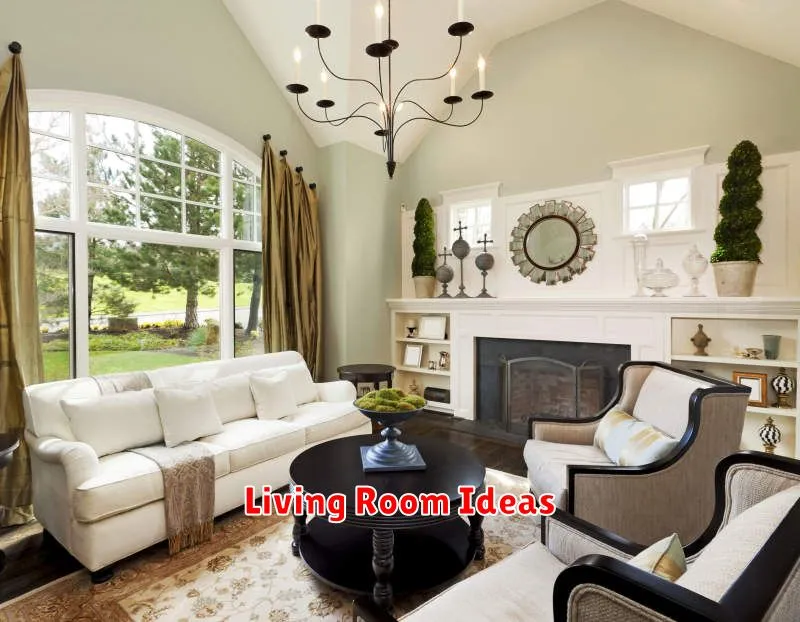Transform your living room into a haven of modern style with our curated collection of 10 modern living room decor ideas. This guide offers inspiring solutions for achieving a chic and stylish look, covering everything from modern furniture choices and sophisticated color palettes to the incorporation of statement lighting and on-trend accessories. Whether you’re aiming for a minimalist aesthetic or a more eclectic vibe, these decor ideas will help you create a living room that reflects your personal taste and elevates your home’s overall design.
Minimalist Furniture Choices
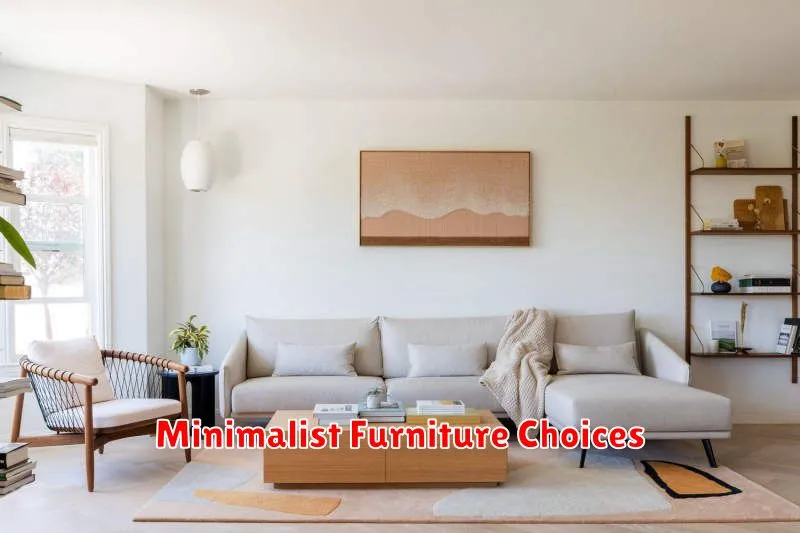
Choosing minimalist furniture involves a careful consideration of both form and function. The goal is to create a space that is uncluttered, clean, and visually calming. This requires selecting pieces that are both aesthetically pleasing and practical, avoiding unnecessary embellishments or excessive ornamentation.
Functionality is paramount. Each piece should serve a clear purpose. Avoid items that are purely decorative without practical value. Multifunctional furniture, such as ottomans with storage or beds with built-in drawers, can maximize space and enhance efficiency.
Simplicity in design is key. Clean lines, simple shapes, and neutral colors are hallmarks of minimalist style. Look for furniture with unfussy silhouettes and avoid overly ornate details. A limited palette of materials, such as wood, metal, or stone, will contribute to a cohesive and serene environment.
Material quality is crucial in minimalist design. Because fewer pieces are used, each item should be durable and well-made. Investing in high-quality, long-lasting furniture is a worthwhile endeavor, as it reduces the need for frequent replacements. Consider the sustainability of the materials and their environmental impact.
Space optimization is a significant consideration. Minimalist furniture tends to be compact and efficient, maximizing floor space and creating a sense of openness. Avoid bulky or oversized pieces; instead, choose furniture scaled appropriately to the room’s dimensions.
In conclusion, selecting minimalist furniture requires careful planning and thoughtful consideration. By focusing on functionality, simplicity, quality, and space optimization, one can create a stylish and serene living space that reflects a mindful and uncluttered lifestyle.
Layered Rugs for Texture
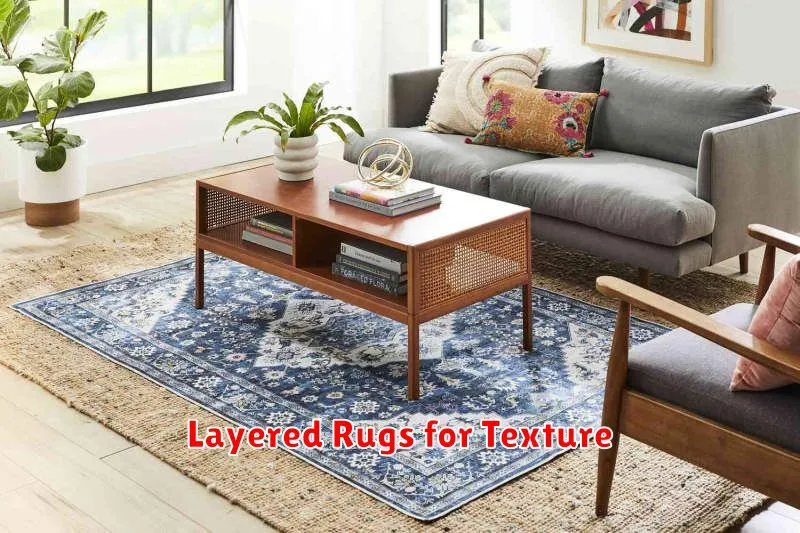
Layering rugs is a simple yet effective design technique that adds depth, warmth, and visual interest to any room. It’s a versatile approach that allows for the creative exploration of texture, color, and pattern, transforming a space from ordinary to extraordinary.
The primary benefit of layering rugs lies in its ability to enhance texture. By combining rugs with different pile heights, materials, and weaves, a captivating interplay of tactile elements is created. A fluffy, high-pile rug layered over a flat-weave jute rug, for example, offers both luxurious softness and a grounding, natural element.
Beyond texture, layering rugs offers practical advantages. Smaller rugs can be used to define areas within a larger space, such as a dining area within an open-plan living room. This zoning technique helps to create a sense of order and functionality while visually separating different areas.
Color and pattern play a crucial role in successful rug layering. Consider using complementary colors or contrasting patterns to create a visually stimulating effect. A bold, patterned rug layered over a neutral-toned rug can add a pop of personality without overwhelming the space. Alternatively, subtle variations in shade can create a more cohesive and sophisticated look.
When choosing rugs to layer, consider the size and proportions of the room and the rugs themselves. The top rug should generally be smaller than the bottom rug, allowing a portion of the under rug to be visible. This creates a sense of balance and prevents the layered rugs from appearing overwhelming.
In conclusion, layering rugs is a versatile and impactful design strategy that offers a multitude of benefits. By carefully considering texture, color, pattern, and size, you can create a unique and inviting atmosphere in any room.
Statement Wall Art
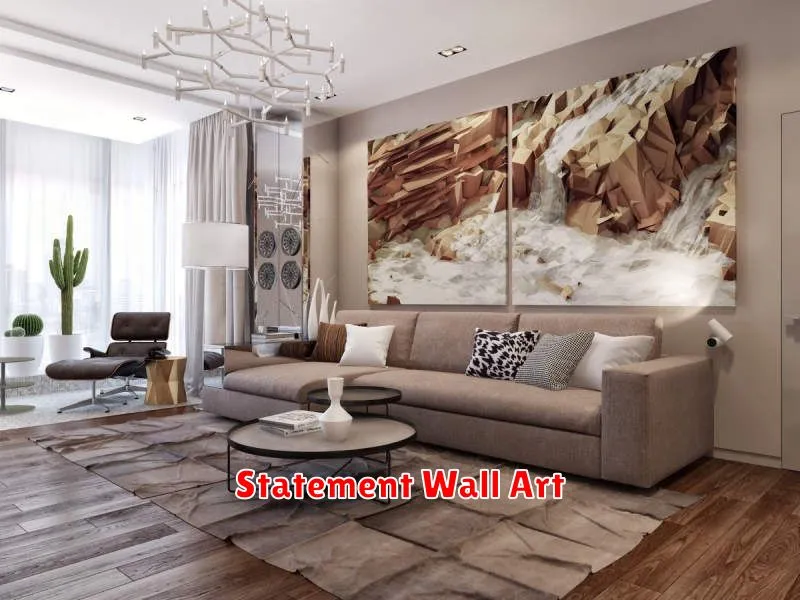
Statement wall art serves as a powerful tool for enhancing the aesthetic appeal and overall ambiance of any interior space. It offers a unique opportunity to express personal style and create a visually captivating focal point.
The selection of statement wall art should be carefully considered, aligning with the existing décor and the desired atmosphere. Factors such as size, color palette, and subject matter play a crucial role in achieving a cohesive and harmonious design.
Various mediums can be employed to create impactful statement pieces. Paintings, sculptures, tapestries, and even creatively arranged photographs can all effectively serve this purpose. The choice depends on individual preferences and the specific aesthetic being pursued.
Beyond mere decoration, statement wall art can significantly influence the mood and functionality of a room. A large, vibrant piece can energize a space, while a calmer, more subdued artwork can promote relaxation. Strategic placement is key to maximizing the impact of the chosen art.
Ultimately, the selection of statement wall art is a deeply personal endeavor. The most effective pieces are those that resonate deeply with the homeowner, reflecting their taste and creating a space that feels both inviting and uniquely their own. Considering the overall design scheme, desired mood, and personal preferences will lead to the most successful integration of statement art within the home.
Neutral Color Palettes
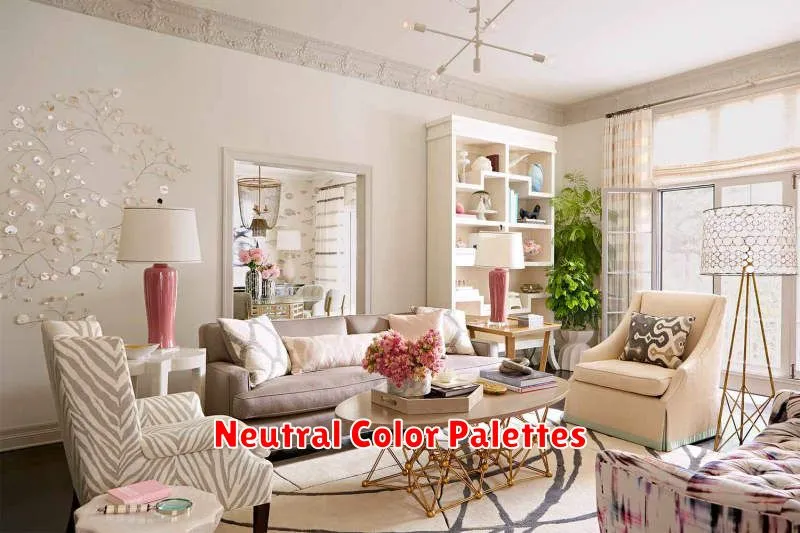
Neutral color palettes offer a sophisticated and timeless aesthetic, providing a versatile backdrop for various design applications. They are characterized by the absence of strong, saturated hues, instead relying on a range of shades derived from black, white, gray, and beige. This inherent versatility makes them exceptionally adaptable to diverse design styles and moods.
The core of a neutral palette is often built around variations of grays. Different shades of gray, from light to dark, provide depth and visual interest without overwhelming the eye. These can be complemented by the addition of creamy beiges or warm, off-white tones, which introduce subtle warmth and texture. Adding black can provide strong contrast and definition, while white offers brightness and airiness.
Beyond the basic components, subtle variations and unexpected textures can elevate a neutral palette. Consider incorporating textured neutrals, such as linen or stone, to add visual interest. The inclusion of metallic accents like silver or gold can also significantly impact the overall feel, adding a touch of luxury or modernity depending on the application.
The beauty of neutral palettes lies in their adaptability. They serve as a perfect foundation for showcasing bold pops of color, allowing accent hues to truly stand out. This makes them ideal for spaces where versatility is key, such as living rooms, bedrooms, or workspaces. The calmness inherent in neutral tones fosters a sense of tranquility and order, creating a relaxing and inviting atmosphere.
When designing with neutral palettes, it is crucial to consider the balance between light and dark shades. Too much of one can create a monotonous look. Careful layering and strategic placement of different tones ensure visual depth and prevent the design from feeling flat. The ultimate goal is to create a harmonious and aesthetically pleasing space that reflects a sense of sophistication and timeless elegance.
Bold Accent Pieces
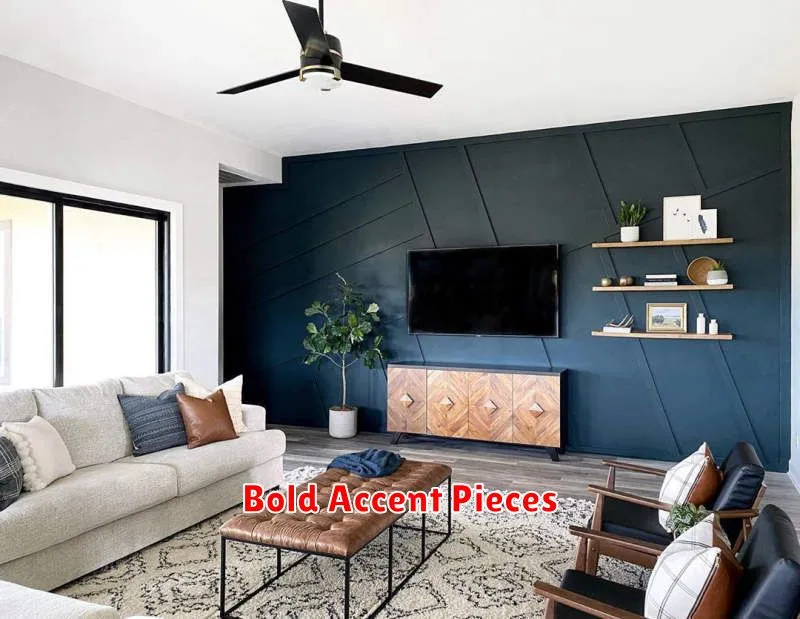
Adding bold accent pieces to your home décor can dramatically transform a room’s aesthetic. These pieces serve as focal points, injecting personality and visual interest into otherwise neutral spaces.
Consider incorporating a statement rug. A large, brightly colored rug can anchor a room and immediately elevate its design. Alternatively, a unique piece of artwork, such as a vibrant painting or a striking sculpture, can become the undeniable centerpiece of a wall.
Lighting fixtures also present an excellent opportunity for bold accents. A chandelier with dramatic features or a series of eye-catching pendant lights can add both style and functionality. The right lighting can even completely change the mood of a room.
Don’t underestimate the impact of smaller accents. A collection of colorful throw pillows, a uniquely patterned vase, or even a set of distinctive candlesticks can all contribute to a bolder, more expressive space. The key is to carefully select pieces that complement each other while showcasing individual character.
When choosing bold accent pieces, it’s important to consider your existing décor. While contrast is key, you want to ensure the pieces work harmoniously with the overall style of the room. A cohesive approach will prevent the space from feeling cluttered or overwhelming.
Ultimately, the use of bold accents is a personal expression of style. There are no strict rules. Experiment, have fun, and create a space that truly reflects your personality and preferences.
Use of Indoor Plants
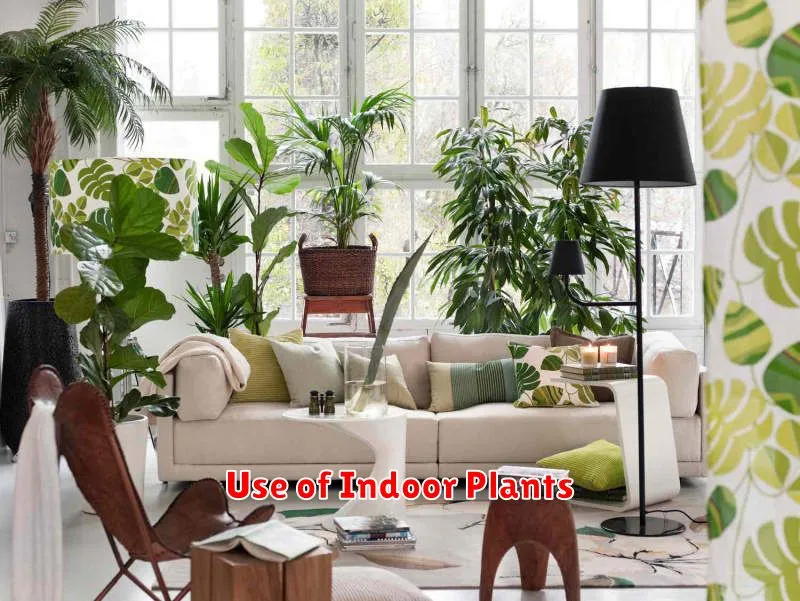
Indoor plants offer a multitude of benefits, transforming a space from drab to fab. Their primary use is purely aesthetic, adding splashes of color and texture to otherwise bland interiors. They can instantly liven up a room, creating a more inviting and pleasant atmosphere.
Beyond the visual appeal, indoor plants also play a crucial role in improving air quality. Through the process of photosynthesis, they absorb carbon dioxide and release oxygen, contributing to a healthier breathing environment. Certain plants are even known to filter out harmful toxins and pollutants from the air, making them particularly beneficial for homes and offices.
Furthermore, studies suggest that indoor plants can have a positive impact on mental well-being. The presence of greenery has been linked to reduced stress levels, improved focus and concentration, and a general sense of calm and tranquility. Caring for plants can also be a therapeutic activity, offering a sense of accomplishment and connection to nature.
From a practical standpoint, some indoor plants can also help regulate humidity levels, which is especially beneficial in dry climates. The addition of plants can add a natural element of humidity to a space, making it more comfortable for both people and other plants. Selecting the right plants for your home is key to harnessing all the many benefits they offer.
In conclusion, the use of indoor plants extends far beyond simple decoration. They offer a holistic approach to improving the environment of your home or office, positively impacting air quality, mental well-being, and even humidity levels. Choosing the right species for your space and providing appropriate care will ensure you reap the numerous rewards these vibrant additions provide.
Smart Lighting Solutions
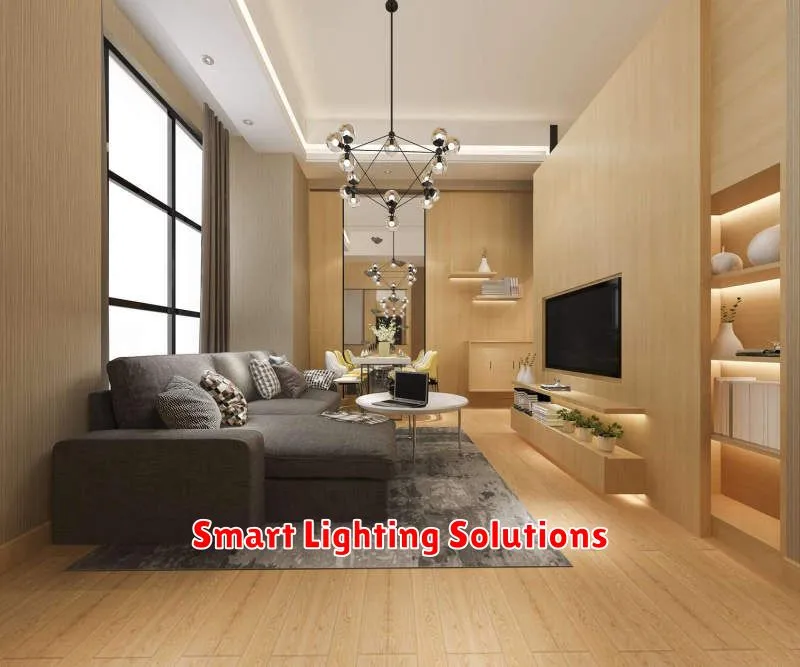
Smart lighting solutions are revolutionizing how we illuminate our homes and businesses. These systems offer a level of control and efficiency previously unimaginable, leading to significant benefits for both convenience and energy savings.
One of the key advantages is remote control. Using a smartphone app or voice assistant, you can easily turn lights on or off, adjust brightness, and even change color temperature from anywhere in the world. This is particularly useful for security purposes, allowing you to simulate occupancy when away from home.
Energy efficiency is another major benefit. Smart bulbs often use less energy than traditional incandescent bulbs, and many systems include features like scheduling and automation to further reduce consumption. You can program lights to turn off automatically when not needed, saving you money on your energy bills.
Beyond functionality, smart lighting offers a significant aesthetic advantage. The ability to customize lighting schemes—from warm, cozy tones to vibrant, dynamic colors—allows for a personalized and expressive home environment. This can greatly enhance the ambiance and mood of any space.
Integration with other smart home devices is another compelling feature. Many systems can seamlessly work with other smart home ecosystems, allowing for complex automation scenarios. For example, you can program lights to turn on when a motion sensor detects movement, or integrate them with your security system for enhanced protection.
While the initial investment might seem higher compared to traditional lighting, the long-term cost savings and enhanced convenience make smart lighting a worthwhile investment. The improved energy efficiency, coupled with the added security and comfort, offer significant value proposition.
In conclusion, the benefits of adopting smart lighting solutions are multifaceted. From enhanced convenience and energy savings to improved security and customizable aesthetics, these systems represent a significant step forward in home and business illumination.
Vintage and Modern Mix

Blending vintage and modern elements in your home décor creates a unique and captivating aesthetic. It’s a style that celebrates the past while embracing the present, resulting in a space that feels both lived-in and sophisticated.
The key to successfully mixing vintage and modern lies in finding a balance. Too much of either style can feel overwhelming. Consider using neutral colors as a base, allowing your vintage and modern pieces to stand out as focal points. A neutral palette provides a cohesive backdrop that allows the unique characteristics of each piece to shine.
When selecting vintage pieces, look for items with interesting details and character. A slightly worn armchair, an antique mirror with a unique frame, or a collection of vintage glassware can add significant charm and personality. These pieces tell a story and bring a sense of history to the space.
To complement your vintage finds, incorporate modern elements that provide a sense of clean lines and contemporary appeal. This could include sleek furniture, minimalist lighting fixtures, or bold graphic art. The contrast between the old and the new creates visual interest and prevents the space from feeling dated.
Texture is also crucial in creating a harmonious blend. Pair the smooth surfaces of modern furniture with the rough texture of a vintage rug or the worn patina of an antique dresser. This interplay of textures adds depth and visual richness to the overall design.
Ultimately, the best way to achieve a successful vintage and modern mix is to curate a collection of pieces that you genuinely love and that reflect your personal style. Don’t be afraid to experiment and have fun with the process! The goal is to create a space that is both stylish and comfortable, a reflection of your unique taste and appreciation for both the old and the new.
Scandinavian-Inspired Designs
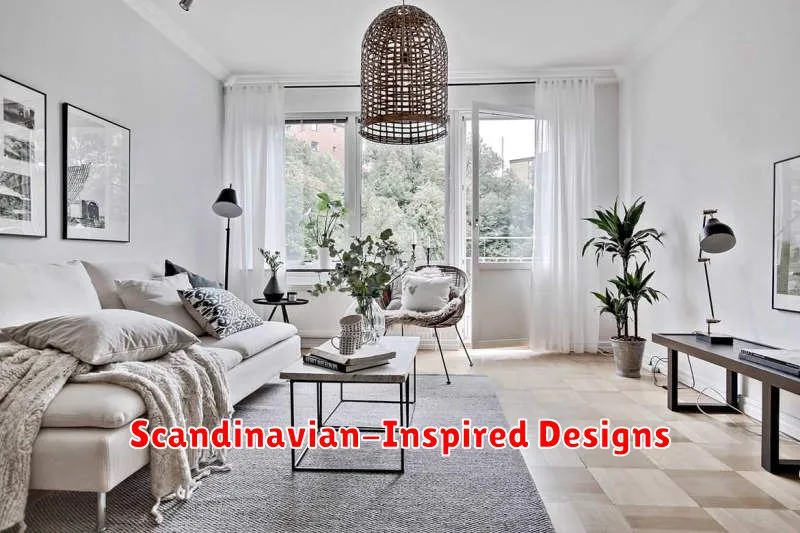
Scandinavian design, also known as Nordic design, is a popular style characterized by its minimalist aesthetic, functionalism, and use of natural materials. It emphasizes simplicity, clean lines, and a sense of calm.
Key elements of Scandinavian design include light, neutral color palettes often featuring whites, grays, and beiges. Accents of bolder colors, such as deep blues or greens, are sometimes incorporated to add visual interest. Natural light is maximized through large windows and strategically placed mirrors.
Materials commonly used in Scandinavian design are wood, particularly light-colored woods like birch and pine; wool; linen; and leather. These materials contribute to the overall feeling of warmth and coziness. The furniture is often simple and uncluttered, emphasizing functionality and clean lines.
The style prioritizes comfort and practicality. Furniture is designed to be both beautiful and useful, and the overall atmosphere strives for a sense of relaxed sophistication. Clutter is minimized to create a sense of spaciousness and serenity.
Scandinavian design’s popularity stems from its timeless appeal and its ability to create a calming and inviting space. Its emphasis on functionality, natural materials, and minimalist aesthetics makes it a versatile style that can be adapted to various settings and preferences.
Whether you’re decorating a small apartment or a large home, incorporating elements of Scandinavian design can create a stylish and serene environment. The focus on simplicity and functionality allows for a sense of calm and order, making it a popular choice for those seeking a clean and peaceful living space.
Functional Coffee Tables
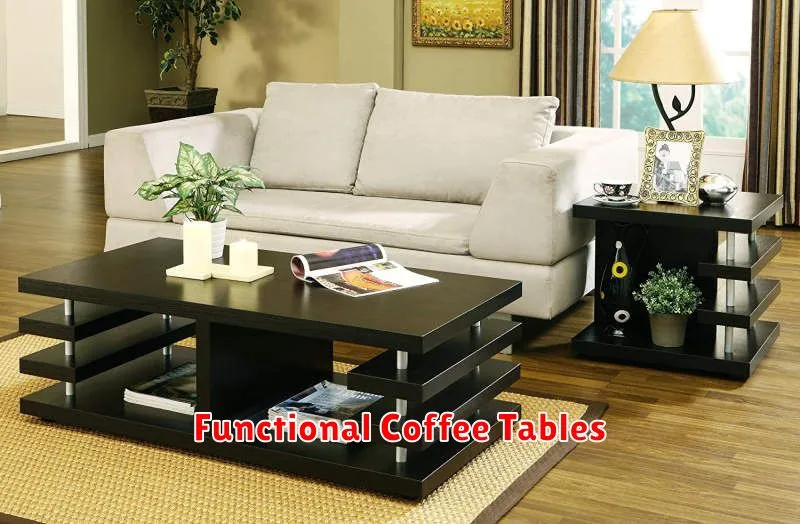
Coffee tables are more than just decorative pieces; they serve a crucial functional role in the living room. They provide a surface for placing drinks, remotes, books, and other items, keeping your space organized and clutter-free.
The functionality of a coffee table depends greatly on its design and size. A larger table offers ample space for entertaining, while a smaller one might be more suitable for a compact living room. Consider the storage options; some coffee tables include drawers or shelves, maximizing their practicality.
Material is another key factor influencing a coffee table’s functionality. Wood coffee tables are durable and classic, while glass or metal options offer a more modern aesthetic. The choice depends on your existing décor and personal preferences. However, consider the ease of cleaning and maintenance when making your decision.
Beyond the basics, think about the height of the coffee table in relation to your sofa. It should be comfortably accessible without requiring you to reach too high or too low. Also, consider the style; a traditional design might complement antique furnishings, whereas a modern table would suit a contemporary setting.
Ultimately, the most functional coffee table is one that perfectly complements your lifestyle and living space. By carefully considering its size, design, material, and height, you can choose a piece that is both aesthetically pleasing and highly practical.

